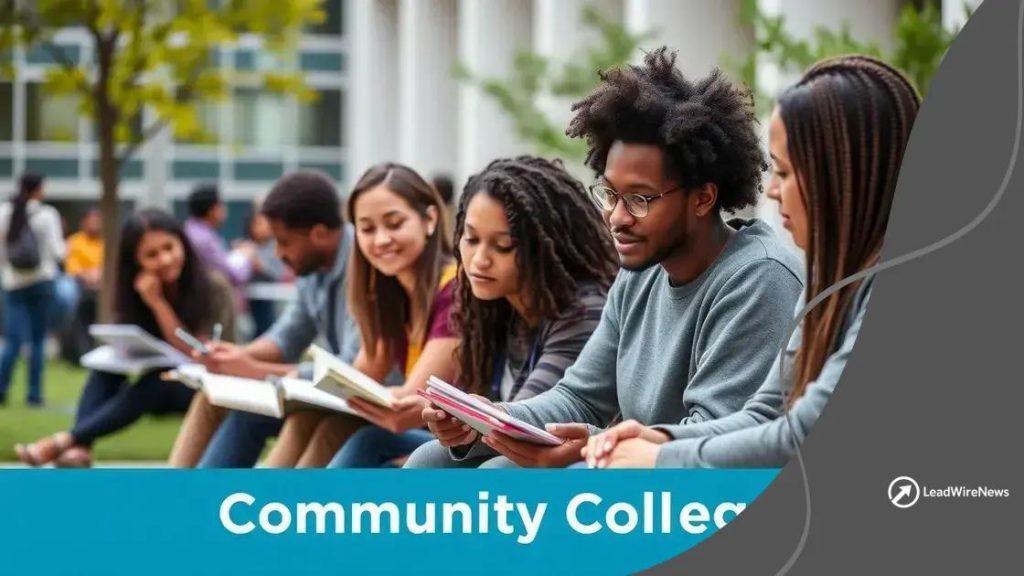Financial aid for community college students: What you need to know

Anúncios
Financial aid for community college students includes grants, scholarships, work-study programs, and loans, each designed to help cover educational costs based on eligibility and financial need.
Financial aid for community college students plays a crucial role in making education accessible. Have you considered how these resources could change your educational journey? Let’s dive into the options available to you.
Anúncios
Types of financial aid available
When exploring financial aid for community college students, it’s essential to understand the various types of aid available. Each option plays a vital role in helping students manage their educational expenses.
Types of Financial Aid
There are several types of financial aid that you can consider. These include grants, scholarships, work-study programs, and loans. Each type has its unique features and requirements.
1. Grants
Grants are a popular form of financial aid that does not have to be repaid. They are often awarded based on financial need. Some important points about grants:
Anúncios
- Federal Pell Grants are available to undergraduate students who demonstrate exceptional financial need.
- State grants may also be offered, depending on your state’s funding for education.
- Institutional grants may be provided directly by community colleges to help students in need.
2. Scholarships
Scholarships can come from various sources, including schools, private organizations, and community groups. Unlike loans, scholarships do not require repayment and can be awarded based on merit or need.
Researching local scholarships can provide additional opportunities. Look out for:
- Community organization scholarships that focus on your local area.
- Merit-based scholarships that reward academic excellence.
- Specific scholarships targeting underrepresented groups in education.
3. Work-Study Programs
Work-study programs allow students to work part-time while attending college. These programs help you earn money to pay for your education and often involve on-campus jobs or community service work.
Participating in work-study can provide valuable experience while easing financial strain. Employers participating in this program are typically understanding of your class schedule.
4. Loans
If grants and scholarships don’t cover all your expenses, you may consider loans. Loans need to be repaid, usually after graduation. It’s crucial to understand the terms and interest rates of loans.
- Federal student loans often have lower interest rates and flexible repayment options.
- Private loans can fill the gap but typically have higher interest rates.
- Always borrow only what you need to avoid overwhelming debt.
In summary, understanding the different types of financial aid for community college students will help you make informed decisions about funding your education. Take the time to explore these options and see what works best for you.
How to apply for financial aid
Applying for financial aid for community college students can seem overwhelming, but it doesn’t have to be. Knowing the steps involved can make the process easier and more accessible.
Step 1: Gather Required Information
Before you start your application, gather all necessary documents. You’ll need:
- Your Social Security number (or Alien Registration number if you are not a U.S. citizen).
- Tax returns, especially if you are filing as an independent student.
- Records of income, such as W-2 forms or pay stubs.
- Bank statements and records of investments.
Step 2: Complete the FAFSA
The next step is to fill out the Free Application for Federal Student Aid (FAFSA). This is a crucial document that determines your eligibility for federal financial aid. You can complete it online at the FAFSA website.
Be aware that:
- The FAFSA form opens every October. Make sure to apply as early as possible.
- Double-check your entries to avoid mistakes that can delay your aid package.
- Consider using the IRS Data Retrieval Tool to import tax information directly.
Step 3: Review Your Student Aid Report (SAR)
After submitting your FAFSA, you’ll receive a Student Aid Report (SAR). This document summarizes your financial information and indicates your Expected Family Contribution (EFC).
Review your SAR carefully:
- Check for any errors in the information you provided.
- If you find discrepancies, reach out to the FAFSA support line for help.
Step 4: Compare Financial Aid Offer Letters
Once your school processes the FAFSA, they will send you a financial aid offer letter. This letter lists the types of aid you qualify for, including grants, loans, and work-study opportunities.
It’s essential to compare multiple letters if you applied to several schools. Look for:
- The total cost of attendance.
- The amount of grants versus loans offered.
- Any work-study positions available.
Taking the time to examine these details can help you make an informed choice about which college to attend.
Throughout this process, remember that support is available. Financial aid offices at community colleges are there to help you navigate the application process, so don’t hesitate to reach out if you have questions.
Understanding eligibility criteria

Understanding the eligibility criteria for financial aid is crucial for community college students. This knowledge helps you navigate the application process efficiently and boosts your chances of receiving assistance.
General Eligibility Requirements
To qualify for most types of financial aid, there are some common requirements to consider. For example:
- You must be a U.S. citizen or an eligible non-citizen.
- You need to have a valid Social Security number.
- You must enroll in an eligible program at a community college.
- You should demonstrate financial need, which is determined through your FAFSA application.
Academic Requirements
In addition to basic eligibility requirements, most aid programs require you to maintain satisfactory academic progress. This typically means:
- Maintaining a minimum GPA, usually around 2.0.
- Completing a certain percentage of attempted credits each term.
- Avoiding academic probation or dismissal from your program.
Being aware of these academic standards is essential for keeping your financial aid.
Special Circumstances
It’s important to note that some students may have special circumstances that affect their eligibility. These can include:
- Dependency status: dependent students must provide parent information, while independent students do not.
- Changes in financial situations, such as job loss or unexpected expenses.
- Previous drug convictions, which can affect federal aid eligibility.
If you believe you have special circumstances, it’s worth discussing them with your school’s financial aid office.
By understanding the eligibility criteria, community college students can ensure they meet the requirements needed to apply for financial aid successfully. Staying informed will help you take full advantage of the support available to you.
Common mistakes to avoid
When applying for financial aid for community college students, avoiding common mistakes can significantly impact your chances of success. Many students unknowingly make errors that can delay or reduce their aid. Here are some mistakes to watch out for.
1. Missing Deadlines
One of the most common mistakes is missing application deadlines. The FAFSA opens every October, and each state may have different deadlines for state-specific aid.
To prevent this:
- Set reminders for important dates related to your application.
- Submit your applications early.
- Check your school’s website for specific deadlines.
2. Incomplete Applications
Submitting an incomplete application is another frequent error. Ensure that you fill out every section accurately. Omitting information can lead to delays.
Here’s how to avoid this issue:
- Review your application before submitting.
- Double-check that all required signatures are included.
- Keep track of any additional documents needed, such as tax returns.
3. Ignoring Financial Aid Offers
Once you receive your financial aid offer, some students forget to follow up or take action. This can lead to missed opportunities for financing your education.
Remember to:
- Review your offer carefully and understand the details.
- Accept or decline aid within the required timeframe.
- Contact the financial aid office with any questions about the offer.
4. Not Understanding Your Financial Aid
Many students fail to fully understand the types of aid offered. Different aid comes with different obligations, especially when it involves loans.
To ensure you know what you’re getting into:
- Ask questions about any part of the aid you do not understand.
- Educate yourself about the differences between loans, grants, and scholarships.
- Review the terms and conditions carefully before accepting any loans.
Being aware of these common mistakes can empower community college students to navigate the financial aid process more effectively. Taking time to understand these pitfalls will help set you on the path to successfully securing financial assistance for your education.
Resources for additional support
Accessing financial aid for community college students is a critical step, but there are also many resources available to help you along the way. These resources can provide guidance, support, and additional information to make the financial aid process smoother.
1. Financial Aid Offices
Your community college’s financial aid office is a valuable resource. They can help you understand the different types of aid available and guide you through the application process.
Some ways they can assist you:
- Offering one-on-one counseling sessions to answer your questions.
- Providing workshops on how to fill out the FAFSA.
- Detailing specific scholarships and grants available to students.
2. Online Financial Aid Tools
Many websites offer helpful tools and guides to navigate financial aid. Websites such as Fastweb and College Board can help you find scholarships that match your profile.
You can also use these tools to:
- Calculate your estimated family contribution (EFC).
- Access scholarship search engines to find opportunities.
- Research information on different financial aid programs by state.
3. Community Organizations
Local organizations often provide resources for students in pursuit of education. These may include non-profits that focus on education and local government programs.
Consider reaching out to:
- Community foundations that offer scholarships based on various criteria.
- Organizations focused on helping underrepresented groups in education.
- Religious or civic groups that may offer financial assistance for education.
4. Peer Support Groups
Connecting with fellow students can also provide support and valuable insights into the financial aid process. Look for:
- Student-led organizations that discuss financial wellness.
- Online forums where students share experiences and tips.
- Workshops hosted by student groups on navigating financial aid.
Utilizing these additional resources can enhance your understanding and experience with financial aid. Taking advantage of the support available can help ensure that you successfully secure the funding needed for your education.
FAQ – Frequently Asked Questions about Financial Aid for Community College Students
What types of financial aid are available for community college students?
Community college students can access various types of financial aid, including grants, scholarships, work-study programs, and student loans.
How do I apply for financial aid?
To apply for financial aid, gather necessary documents, complete the FAFSA online, and review your Student Aid Report (SAR) once it is available.
What are some common mistakes when applying for financial aid?
Common mistakes include missing application deadlines, submitting incomplete applications, and failing to follow up on financial aid offers.
Where can I find additional resources for financial aid support?
Additional resources can be found at your community college’s financial aid office, online financial aid tools, and local community organizations.